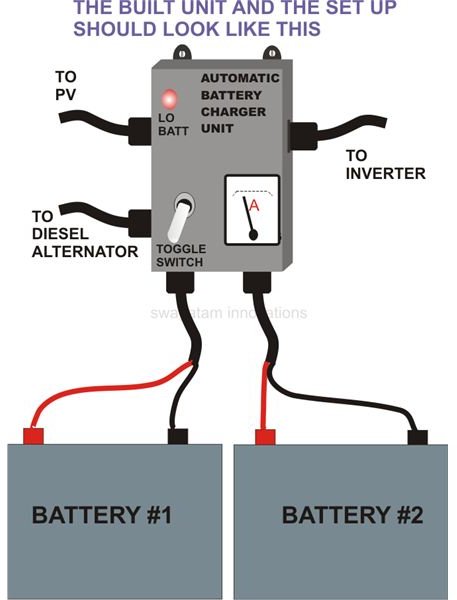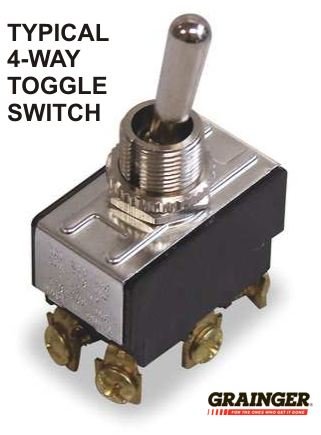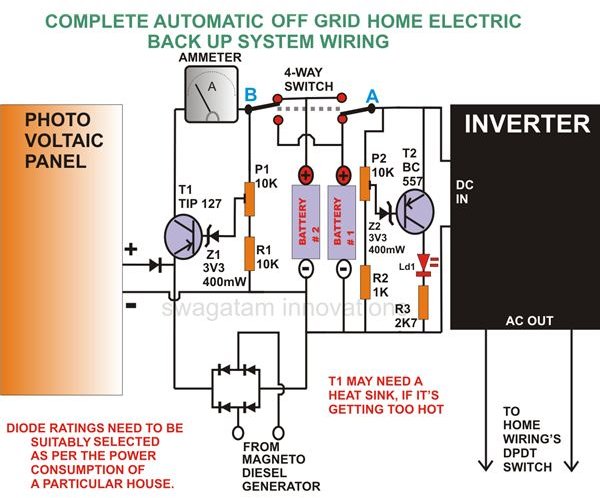How to Build Off the Grid Generator Battery Home Backup Systems
Going Green
With human population ever increasing, our cities are growing more and more power hungry. Although the government of each nation is trying their best to cope up with the problem but the situation is getting grimmer as days pass by. As a result, frequent power interruptions and load shedding have become quite a common occurrence in many parts of the countries today. In the present scenario, for the newly built, remotely located house, getting electric supply through the conventional means seems highly unfeasible, mostly because of the uneven terrain and due to its distance from the mainstream cities.
A cool solution for the above problems in the form solar powered electricity may seem quite handy as it can be harnessed easily, is available plentifully and what’s more, it’s totally free of cost. Of late people have started understanding the potential benefits of such a power source and have become pretty busy installing their own little power grids made up of solar panels, batteries and inverters.
But, as we all know, every good thing is always accompanied with a bit of snag. Solar powered electricity, as the name refers, may be heavily dependant on sun light. An over cast condition would then mean, the solar panels are producing not enough power to charge the inverter battery and things may turn quite gloomy inside your house.
Well, the solution may again lie in the hands of Mother Nature. Ever wondered how your car battery always remains charged and in a topped up condition whenever required? It’s the powerful alternator inside every vehicle that keeps producing the required charging current for the battery as long as the vehicle is running. Such a diesel or petrol (fossil fuel) powered generator, when integrated with the existing solar power generator to charge the inverter batteries, may prove to become an ultimate off the grid generator battery home backup system.
Here we will learn how simply the three units (solar panels, Inverter and the Alternator) may be wired together so as to produce a continuous 24-7 supply of electric power to your house.
We have included two batteries in the system; while one is being used up by the inverter, the other gets charged, through either the PV or the alternator and is kept ready to be replaced when the first one gets discharged. Since the whole system is quite automatic, the operations become very simple and user friendly.
Circuit (Wiring) Description
We won’t discuss here regarding the specifications and power (AH) delivering capacity of the units (solar panel, inverter, battery, generator etc.) involved in the set up as it would be better to leave it to the experts (dealers and manufacturers). They will be in a better position to exactly judge the approximate power requirements of a particular house and do the installations appropriately. Moreover, if the installation specifications are optimized as per your calculations, it may become difficult to get a refund or a reinstallation done in case you miscalculate the parameters.
The circuit operation may be understood through the following explanation:
Referring to the adjoining figure (Click to Enlarge), let’s assume initially, one battery to be fully charged and the other partially discharged.
Let the charged battery be connected to “Battery #1” position and the discharged one to “Battery #2” position.
Now, according to the shown position of the 4-way switch, two things will instantly start happening: the inverter will be switched ON at once, powering the entire house, and, if it’s quite sunny outside, the battery #2 (partially discharged) will start getting charged through the PV set up.
If, unfortunately, the climate is not on your side, simply switch ON the diesel generator until the battery #2 is fully charged. The Ammeter will give you an instant indication of the charging status. The charging process may take as long as 10 hours; keep a watch on the ammeter, once it approaches the zero mark, you may switch OFF the Alternator. This procedure has been purposely kept manual for safety reasons.
T1 along with R1, D1, and P1 form a self regulating automatic battery charger circuit. It will strictly monitor the charging voltage of the uncharged battery and will restrict any voltage from the PV or the generator once it gets fully charged. So, the battery is ultimately always safe from over charging.
The 4-way switch will need a manual toggling every time the low voltage indicator comprising of T2, P2, R2 and LD1 becomes active. The toggling would mean an instant changeover of the discharged battery with the charged one, so that the cycle may start all over again.
The next page will teach you everything about the construction and the set up procedure for this off the grid generator battery home backup system.
Parts List
The following components will be required to build the present set up:
R1 = 10K 1/4W CFR,
R2 = 10K 1/4W CFR,
R3 = 2K7 1/4 W CFR,
P1, P2 = 10K Preset Linear,
T2 = BC557,
T1 = TIP 127 (one transistor can handle 2 amps. maximum, so connect more transistors in parallel as required),
LED = Red 5 mm,
D1, D2 = 3V3, 400mW Zener Diode,
General Purpose PCB,
Heatsink For T1,
Metallic Enclosure = 1 no,
External Fittings = Sockets, Fuse Holder, Plug etc.
*Rectifier Diodes = 5 nos,
*Ammeter = 1 no,
*4 – Way Changeover Switch, Heavy Duty = 1 no,
*Solar Panel = 24 Volts Maximum Output,
*Diesel Electric Generator = 24 Volts Maximum Output,
*Battery #1 and Battery #2 = Two Sets of Battery,
*Inverter = 1 Unit.
* = All are rated for the power requirement (CURRENT) of a particular house.
Caution: Transistor T1, all rectifier diodes and the 4-way switch are critical components and will have to be suitably selected for the power requirement of a particular house. Assistance of an electronic engineer is strictly recommended.
Construction Clues and Setting

A ready made automated built-in battery charger set up with a solar panel or a diesel AC generator is difficult to find and procure, or may be too costly and complicated. The simple circuit design provided here will make almost everything automatic and will cost you not even a dollar (barring the 4-way switch and the ammeter)
The present discussion will provide you a complete solution about how to live off the grid, as far as electricity is concerned.
You may want the help of a professional electronic engineer for building the little circuit and also for the wiring tips.
The discrete electronic components may be simply procured from your local electronic retailer and assembled over a small piece of general PCB. The whole unit may be housed inside a strong, clampable metallic box, big enough to hold and support the circuit, the 4-way switch and the ammeter. It also should have appropriately drilled sections for the various external sockets and fittings.
(Click Images to Enlarge)

Once the above construction is completed, the setting procedure may be done in the following manner:
-
Initially, keep the PV panel, the batteries and the inverter disconnected from the above unit.
-
Using an external 0 -24V DC variable supply, apply a voltage of around 11 volts across POINT A and ground. Slowly adjust P2 to make the LED glow at its maximum illumination. Now, increase the voltage to about 13 volts, you will find the LED slowly dying OFF and shut down. This sets up the low voltage indicator section.
-
Next, shift the external DC supply across POINT B and ground, also connect the emitter of T1 with the positive of the supply using a jumper wire. Now, increase the voltage to about 13.5 volts, start adjusting P1 until the ammeter just reads zero. This sets up the over charge protection circuit.
-
Now the system is all set to go. Plug in the inverter and the PV wires into the circuit box’s sockets. To start with, connect two fully charged batteries into the two battery sections and switch the system ON.
-
Immediately, the inverter should switch into action powering up the whole house. You don’t have to bother about the rest of the functioning of the system, as everything will be taken care of appropriately and automatically as per the desired specifications. Just remember to toggle manually the 4-way switch when you see the low voltage LED glowing brightly. Also, during overcast conditions, switch the generator ON and monitor the ammeter in between. When you find it “dead”, it would mean the battery is fully charged and supply to it has been restricted by the automatic system. Now you may switch the generator OFF, just to avoid the unnecessary wastage of diesel. During sunny days even this botheration will be eliminated as then everything will be handled by the PV panels and the automatic battery charger circuit.
f you have any further questions about how to live off the grid (electricity), your comments are always welcome (comments need moderation, may take time to appear).
